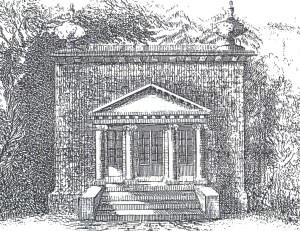Restoration Intern Beauty in the Woods
7 August 2015

Charles Bridgeman designed this ‘bewildering’ wilderness garden with six feet tall hedges to hide the central Sleeping Parlour from the exploring visitor, so one would stumble upon it amongst the maze of pathways. The parlour itself was built to recall the fairy tale of Sleeping Beauty in the Woods.
Landscape historians have suggested that Cobham, who was very much involved in the plans, and Bridgeman, head gardener at the time, designed the New Wilderness based on a similar garden feature created at Versailles by André le Nôtre - the Labyrinth, which was developed from 1666 through 1672.
The Labyrinth at Versailles also incorporated clearings at the points of intersection between and among walks, showcasing a series of fountains, each of which was associated with one of the fables of Aesop. This was the idea of Charles Perrault. Perrault himself published a volume in 1675 that offered prose versions of the fables that he had composed, as well as engravings of the fountains in the Labyrinth.
Perrault’s subsequent publication in 1697 of a volume of fairy tales is what connects him with Stowe. One of the tales is Perrault’s revised and expanded version of the Grimm Brothers’ story ‘Briar Rose’, which he re-titles ‘Sleeping Beauty’. This is the fairy tale of a princess who, under the curse of a disgruntled fairy, pricks her finger on a spindle and falls asleep for a hundred years until a prince comes to rescue her. During that century, a wood grows up around the princess’s castle (in the Grimm Brothers’ version, a thicket of briars) so that the valiant prince must fight his way through. Stowe’s Sleeping Parlour, located from 1725 to 1760 in the central clearing of the Sleeping Wood, represents the palace in Perrault’s tale, particularly since a corresponding structure, directly across the Abele Walk in the eastern garden, was called the Witch House.
When Earl Temple inherited Stowe, he brought his own gardener from Wotton, Buckinghamshire, with him. They destroyed the Sleeping Parlour, amongst making many more modifications, in an attempt to loose the garden from its formal chains. Today an imprint of the pre-1770 Sleeping Parlour, the location discovered using an archaeological technique called Geophysical mapping, has been restored. Benches have been engraved in imitation of its crowning urns - the originals were moved to stand on Oxford Bridge.
However, planting reflects the later dating of the rest of the garden, with American shrub varieties, such as the Cotinus Obovatus ‘Smoke Bush’, which only became available then. These plants would have added greater colour, and the loss of the tall, clipped hedgerows made it a more naturalistic, wooded space.
The National Trust wants to tell the stories of Stowe’s development, as each change has its own significance and tale to tell, although not all of them to do with fairy’s! But this is why the Sleeping Wood has been restored in an interpretation of its history rather than to one date.